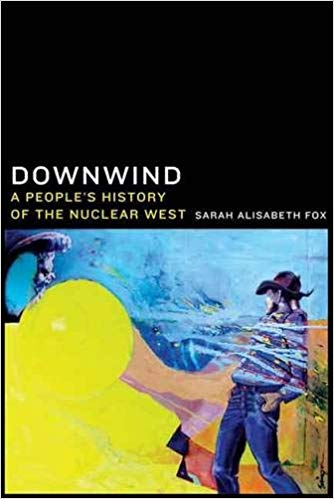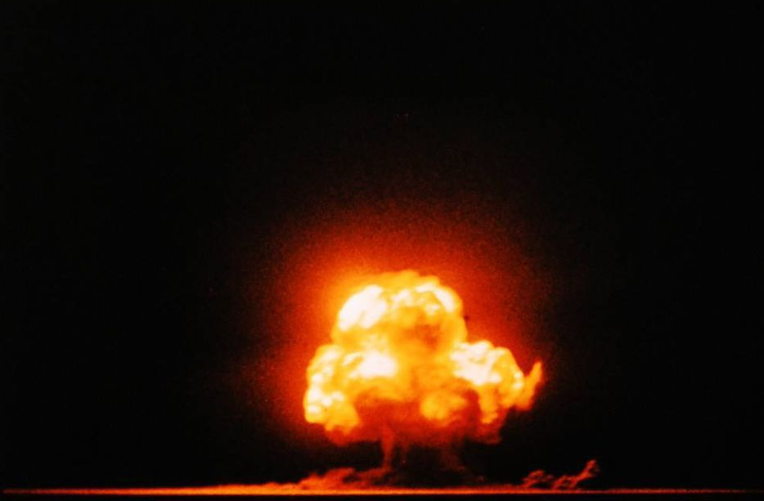 Downwind: A People’s History of the Nuclear West
Downwind: A People’s History of the Nuclear West
By Sarah Alisabeth Fox
306 pp. Bison Books; reprint edition – Sep. 2018. $19.95.
Downwind manages the triple feat of being at once a rigorous piece of scholarship, a moving account of a dark and ongoing period in human history and an exquisitely accomplished first book. Its author, Sarah Alisabeth Fox, spent a decade studying the lives of Americans whose environment was contaminated by the atomic tests of the 1950s to early `60s, as well as by the uranium industry that supported those tests. Through interviews and other field-based methods, she learned the stories of farmers and ranchers economically ruined by mass crop failures and animal die-offs, communities devastated by cancer epidemics and indigenous uranium miners sent to work in deplorable conditions that caused them chronic illness and premature death. Fox supplements her ethnographic work with extensive primary and secondary literature research spanning multiple fields. The end result is, by turns, a tragic, cautionary, fascinating and inspiring read.
Fox vividly captures the sheer destructive force and otherworldly nature of the explosions. Each one began with a flash bright enough to light up pre-dawn skies. (Though this detail doesn’t appear anywhere in the book, servicemen stationed within close range of the blasts have said the light shone so brightly that you could see the bones and blood vessels throughout your body even with your eyes closed.) Next came a shock wave strong enough to rattle windows miles away, followed by a mushroom-shaped cloud thousands of feet high. As this cloud drifted, it lost its mushroom appearance but retained a distinctive reddish-gray hue from all the dirt and debris sucked up by the explosion. Those unlucky enough to be underneath the cloud received a visible dusting of radioactive particles that caused their skin to redden and burn. Livestock developed sores around their mouths from grazing radioactive pastures. Radiation built up in the animals’ milk and meat and caused them to give birth to stillborn or deformed offspring.
The image of the AEC that emerges from Fox’s research is a horrifying one. In the name of national security, the commission perpetrated a litany of abuses against the people of the region. AEC officials assured the public that the tests were safe, even though volumes of since-declassified documents clearly show they knew differently. Local residents could tell the AEC knew something of the true danger level by the fact that detonations occurred only when the wind was blowing away from major population centers like Las Vegas and California to the west, and toward the sparsely populated regions to the east. Throughout the testing era, AEC monitors routinely measured radiation levels across landscapes and communities downwind of the tests, but never reported their findings back to those who had to live amidst the radiation. Along with the U.S. Public Health Service, the AEC also violated the Nuremberg Code by studying the health effects of radioactivity on uranium workers without obtaining the workers’ informed consent.
The government’s actions went mostly unquestioned during the early testing era. To understand why this was the case, it’s necessary to grasp both the politics of the day and the cultural forces then at work in downwind and uranium-producing communities. Fox does a superb job of situating her history within both of these contexts. She reminds us that the Cold War years were a time when to question the government was to risk being labeled a Communist, which meant being blackballed from American society. In addition, much of the downwind population belonged to the Mormon church, which strongly supported the government and discouraged church members from dissenting against government policies. On the whole, writes Fox, people in this part of the country were “self-identified patriots who prized national security and enthusiastically supported the U.S. government’s efforts in the Cold War.”
Much of the uranium needed to make nuclear weapons was located on indigenous lands, a circumstance that Fox reveals led to one of the more egregious cases of environmental discrimination in America’s history. Lured by the prospect of well-paying work close to where they lived and misled about the dangers of working in uranium mines and mills, large numbers of indigenous people went to work for uranium companies. These workers were exploited and made to toil in more toxic conditions than those in which their white counterparts worked. They also unknowingly poisoned their own livestock and families by sheltering their animals in abandoned uranium sites, using mine waste as building materials in their dwellings and allowing their children to play in mine tailings. The waste remains a grave threat to indigenous communities to this day, with vast radioactive plumes steadily making their way toward major sources of drinking water.
Early on, people in downwind communities began to suspect a link between test site fallout and human and animal illness. Fox describes how this suspicion became certainty for many during the spring of 1953. That was when the AEC commenced one of its most large-scale test series ever, the Upshot–Knothole series. It’s also when a mysterious illness began decimating southern Utah’s lamb crop, driving many ranchers toward insolvency and crushing local economies. The AEC blamed the ranchers for the sheep deaths, baselessly alleging that they had allowed the animals to become malnourished. A group of ranchers sued the government but lost because the documents needed to prove their case had conveniently been classified by the AEC. Though the ranchers would never be compensated for their losses, they would be vindicated many years later by a study that found fallout exposure to be the most likely cause of the sheep deaths.
Downwind details many of the erroneous assumptions that AEC experts initially made about radioactive isotopes and their effects on living things. To take a few examples, they believed that extremely low radiation levels posed no danger, that regions farther away from tests would receive less radiation than those nearer and that the milk of irradiated cows would be safe to consume because the animals’ digestive systems would break down the radionuclides. We now know every one of these assumptions to be false. In reality, radiation is unsafe at any dose; the amount of it that ended up in a downwind community after a test was determined not by proximity to the test but by local factors such as moisture level, elevation and local livestock feeding practices; and radioactivity doesn’t break down, but rather accumulates, in the bodies of organisms, as well as becoming more concentrated as it moves up the food chain.
The author powerfully describes the rise of today’s downwinder activist movement, which began when people—predominantly mothers—in communities stricken by illness and death independently began keeping lists of the names of deceased family members, friends and neighbors. In their efforts to understand the illness patterns they were seeing around them, these list-makers became citizen scientists. The book offers lively portraits of a number of these women, whom it refers to as being “part of a global and historical phenomenon in which mothers are a driving force behind movements for change.” Motherhood, explains Fox, has a way of making activists out of women who have previously shown little interest in politics or social issues.
Indigenous communities went through their own process of discovery about the harm being done to them and the environment by atomic testing, though justice has proven more elusive for them than for other groups of radiation-affected people. The U.S. government, notes Fox, is slow to add communities of color to the Superfund National Priorities List, and the eventual cleanup efforts often amount to mere bandage solutions. Fox also goes into some of the obstacles indigenous people face in their efforts to apply for compensation for their radiological exposure. For example, they’re required to submit official documents such as birth, marriage and death certificates, even though these sorts of records often weren’t formally kept on reservations decades ago, and many have questioned why they’re necessary.
Fox’s survey of the post-atmospheric-testing period extends up to 2014, the year in which this book first came out in hardcover. Topics covered include advancements in our knowledge about radiation’s ecological and health effects, growing awareness about the hidden biases and vested interests that stand in the way of good science on these issues, shifts in public opinion about nuclear testing in the wake of the Chernobyl and Three Mile Island disasters and the tireless advocacy that led to legislation like the landmark Radiation Exposure Compensation Act (RECA) of 1990. Fox covers each of these topics, and many others, with great thoroughness, elegant prose and a gift for drawing sharp thumbnail biographical sketches.
As meticulous as Downwind is overall, one part of it isn’t as fully developed as the rest. For all the fine detail that imbues its portraits of ranchers, sheepherders, miners and activists, the book devotes just a few paragraphs to the experiences of veterans who took part in bomb tests. In an email to me, Fox explained that she chose to focus primarily on the stories of civilian downwinders coming to terms with radiological risk in their local environments because she couldn’t find any atomic vets to interview during her initial years of fieldwork. While I understand that every researcher is hostage to the evidence at his or her disposal, I can’t help pining for a more comprehensive history that does the vets justice. (Those interested in compelling accounts of the atomic vet experience should check out Morgan Knibbe’s award-winning documentary short from earlier this year titled The Atomic Soldiers, which interviews several surviving vets.)
In her concluding remarks, Fox stresses how instrumental the stories of radiation-affected people have been in bringing about more enlightened policies, laws and attitudes related to nuclear technology, as well as justice for those impacted by nuclear testing activities. She credits these stories with helping spur test bans, toxic site cleanups, radiation compensation laws and epidemiological studies, among many other things. Fox’s book illuminates and preserves for posterity the grander narrative within which each of these individual stories exists, and in so doing performs a tremendous service for all of humanity.






